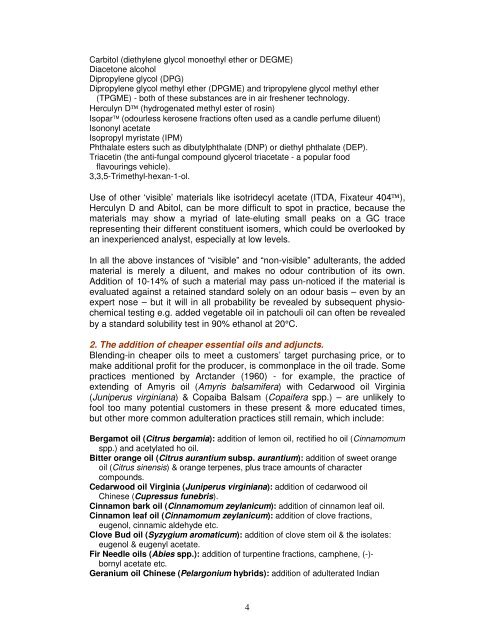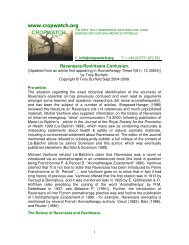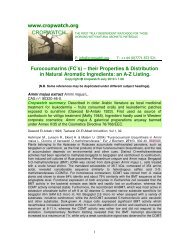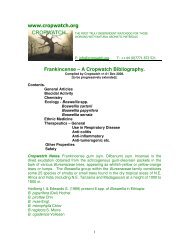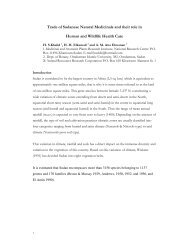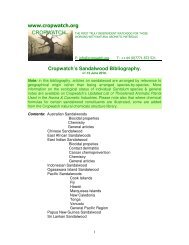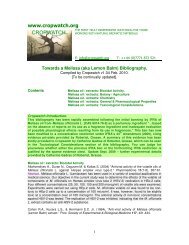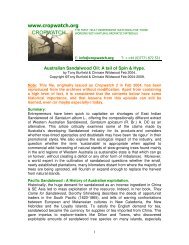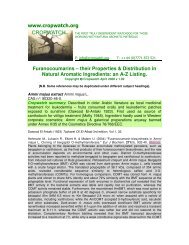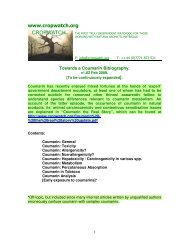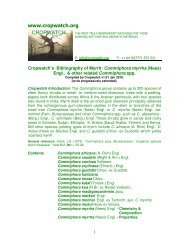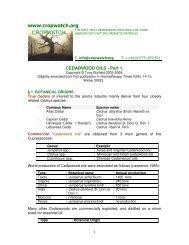The Adulteration Of Essential Oils - Cropwatch
The Adulteration Of Essential Oils - Cropwatch
The Adulteration Of Essential Oils - Cropwatch
Create successful ePaper yourself
Turn your PDF publications into a flip-book with our unique Google optimized e-Paper software.
Carbitol (diethylene glycol monoethyl ether or DEGME)<br />
Diacetone alcohol<br />
Dipropylene glycol (DPG)<br />
Dipropylene glycol methyl ether (DPGME) and tripropylene glycol methyl ether<br />
(TPGME) - both of these substances are in air freshener technology.<br />
Herculyn D (hydrogenated methyl ester of rosin)<br />
Isopar (odourless kerosene fractions often used as a candle perfume diluent)<br />
Isononyl acetate<br />
Isopropyl myristate (IPM)<br />
Phthalate esters such as dibutylphthalate (DNP) or diethyl phthalate (DEP).<br />
Triacetin (the anti-fungal compound glycerol triacetate - a popular food<br />
flavourings vehicle).<br />
3,3,5-Trimethyl-hexan-1-ol.<br />
Use of other ‘visible’ materials like isotridecyl acetate (ITDA, Fixateur 404),<br />
Herculyn D and Abitol, can be more difficult to spot in practice, because the<br />
materials may show a myriad of late-eluting small peaks on a GC trace<br />
representing their different constituent isomers, which could be overlooked by<br />
an inexperienced analyst, especially at low levels.<br />
In all the above instances of “visible” and “non-visible” adulterants, the added<br />
material is merely a diluent, and makes no odour contribution of its own.<br />
Addition of 10-14% of such a material may pass un-noticed if the material is<br />
evaluated against a retained standard solely on an odour basis – even by an<br />
expert nose – but it will in all probability be revealed by subsequent physiochemical<br />
testing e.g. added vegetable oil in patchouli oil can often be revealed<br />
by a standard solubility test in 90% ethanol at 20°C.<br />
2. <strong>The</strong> addition of cheaper essential oils and adjuncts.<br />
Blending-in cheaper oils to meet a customers’ target purchasing price, or to<br />
make additional profit for the producer, is commonplace in the oil trade. Some<br />
practices mentioned by Arctander (1960) - for example, the practice of<br />
extending of Amyris oil (Amyris balsamifera) with Cedarwood oil Virginia<br />
(Juniperus virginiana) & Copaiba Balsam (Copaifera spp.) – are unlikely to<br />
fool too many potential customers in these present & more educated times,<br />
but other more common adulteration practices still remain, which include:<br />
Bergamot oil (Citrus bergamia): addition of lemon oil, rectified ho oil (Cinnamomum<br />
spp.) and acetylated ho oil.<br />
Bitter orange oil (Citrus aurantium subsp. aurantium): addition of sweet orange<br />
oil (Citrus sinensis) & orange terpenes, plus trace amounts of character<br />
compounds.<br />
Cedarwood oil Virginia (Juniperus virginiana): addition of cedarwood oil<br />
Chinese (Cupressus funebris).<br />
Cinnamon bark oil (Cinnamomum zeylanicum): addition of cinnamon leaf oil.<br />
Cinnamon leaf oil (Cinnamomum zeylanicum): addition of clove fractions,<br />
eugenol, cinnamic aldehyde etc.<br />
Clove Bud oil (Syzygium aromaticum): addition of clove stem oil & the isolates:<br />
eugenol & eugenyl acetate.<br />
Fir Needle oils (Abies spp.): addition of turpentine fractions, camphene, (-)-<br />
bornyl acetate etc.<br />
Geranium oil Chinese (Pelargonium hybrids): addition of adulterated Indian<br />
4


